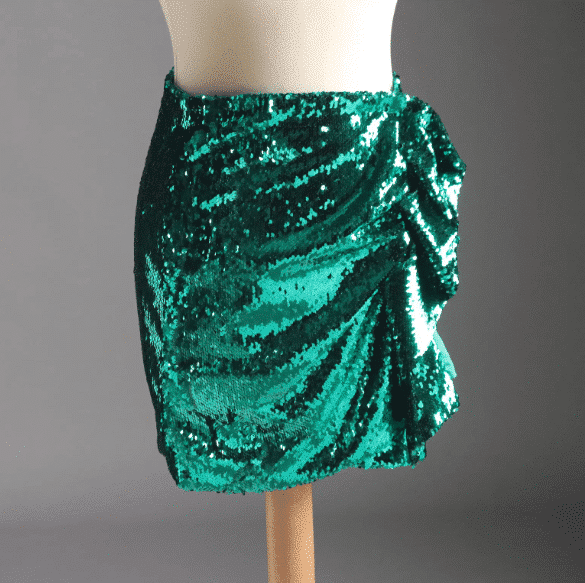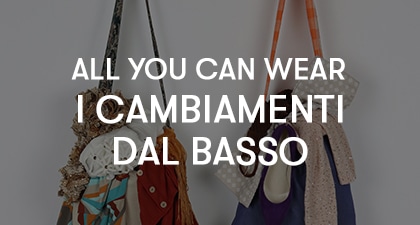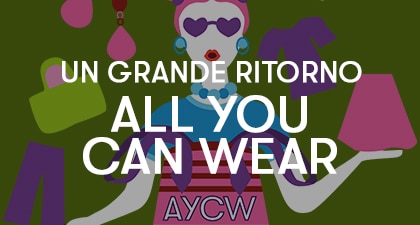A rainbow of colors: GREEN

Dear friends and color enthusiasts, here we are at the fourth color in our series: green. As we did with the other colors, we will analyze its psychological and symbolic meanings, both positive and negative, and we will suggest the best uses for this color in clothing and beyond.
Between Blue and Yellow
To understand the symbolic meanings of green, it is interesting to note its proximity to blue. In the process of semantic differentiation, it is indeed blended with blue hues.
Chromatically, green comes from a mix of blue and yellow. Blue, as we will see later, has characteristics that are opposite to those of yellow: it tempers it. The result of this blend is green, a color of stillness and calm, balance, and harmony.
It sits between blue, which represents the mind, red, which represents the body, and yellow, which symbolizes the emotional self.

Symbolic Meanings of Green
The color of nature, it is an archetype of vegetative life and also of the vegetative aspect within humans.
It is the color of spring, symbolizing beginnings and novices (think of the expression “budding artist”). It represents the early and youthful stages of life (“the green years”) and also things that are unfinished (as in “green fruit” meaning unripe, not yet matured, in a stage preceding its full expression).
Green is an archetype of the vegetative and germinal forces of the Self.

Positive Traits of Green
We can perceive many shades of green, more than other colors, perhaps because humans have always experienced it. It is associated with primordial connections: where there is green, there is vegetation, and thus water and food.
The continuum between positive and negative poles of green is therefore rich in meanings that often depend on the specific shade of the color.
When green is positive, it represents new life and growth, but also evokes feelings of security and stability. It is a soothing color that expresses harmony and balance. Other positive meanings of green include: objectivity, refreshment, rest, reassurance, and peace.

Negative Traits of Green
We mentioned that green’s meanings depend greatly on the many shades we can perceive. To clarify this, consider an example: aquamarine green is refreshing and regenerating. In contrast, olive green can feel heavy and dull.
On the negative side, some shades of green or their excessive use can evoke feelings of boredom, stagnation, decomposition, and deterioration.
Green can convey sloppiness, envy, jealousy, or stagnation (let’s remember that green is the color of mold or stagnant water with algae and decayed vegetation).

Green in Sustainability Branding
Due to its strong connection with nature and vegetation, green (like earthy colors) is widely used to communicate sustainability. Consider clothing: many lines that have emerged in recent years claiming to be sustainable (though not always truly so) have included green in their branding.

When to Wear Green
The range of dark greens is an excellent choice if you need to put people at ease. For example, if you are a professional such as a psychologist or psychiatrist, or if you are meeting someone for the first time and want to ease potential tension or embarrassment.
Bright greens, like lime green, are challenging to use and should be applied sparingly. Lime green is great if the goal is to create energy around you because it stands out, is vibrant, and restless. In sales, it is excellent as a detail to convey movement and dynamism to buyers.
In general, less vibrant shades of green are the most commonly used in clothing. These shades are associated with qualities such as timeless elegance, geometric and understated styles, and are chosen to convey reassurance and importance to the wearer.
Finally, on a positive note, green is one of the quintessential colors of Christmas. Every year, we celebrate rituals centered around a tree and mistletoe, and we often dress in this color, expressing the desire for the Self to remain evergreen.
As you may have guessed from previous posts, Raffaella and I had fun creating a look for this color too. Certainly a bit festive, definitely a lot of fun. Here’s the result.


Raffaella is wearing an outfit with items from the Cambiago store:
- Sweater in vintage green wool with print and applications, fits sizes XS and S, €15.
- Skirt in vintage green suede, size Small, €45.
- Bag with floral print by Ken Scott, vintage, €25.
- Scarf by Hermes, vintage, €50.
- Gold second-hand pumps, €5.
When to Avoid It in Looks
A dark green used excessively can convey slowness, boredom, and a lack of energy. Therefore, avoid overusing it in new work situations, when you want to appear fast, proactive, and enthusiastic.
As for bright greens, excessive use can turn dynamism into a sense of irritation, stress, and anxiety. Avoid it if you work with hyperactive children or are a parent of children who struggle to concentrate, as it could further stimulate the nervous system.
In the Mood for Green?
If this article has piqued your curiosity and you’d like to add a touch of green to your wardrobe, here are some options you might find on our website.



Green Full Sequined Mini Skirt by Pinko, Vintage Green Shoes, Vintage Floral and Parrot Dress.



Missoni Sheath Dress, Vintage Suitcase and Beauty Case, Gigliola Curier Vintage Sweater.



Vintage Green Gucci Shoes, Vintage Green Yves Saint Laurent Jacket, Vintage Green Reptile Bag.
We remind you that this weekend, the last before Christmas (December 17/18), we will be open in both Milan and Cambiago with continuous hours from 10 am to 7 pm. We look forward to seeing you to exchange greetings and bid farewell before the holidays!
Bibliography
- Claudio Wildmann, “The Symbolism of Colors”
- Karen Haller, “The Little Book of Color”








